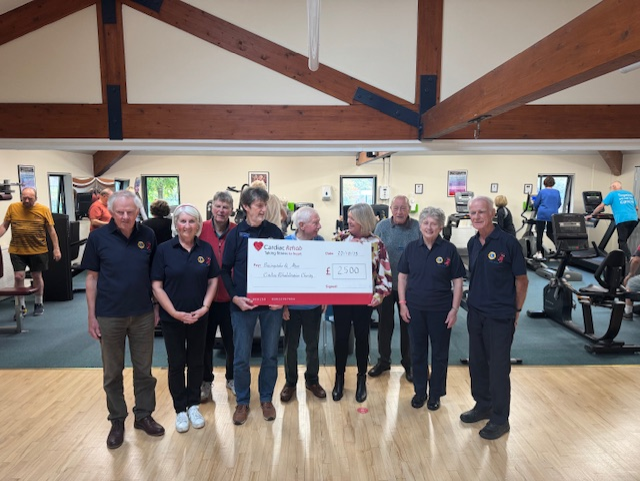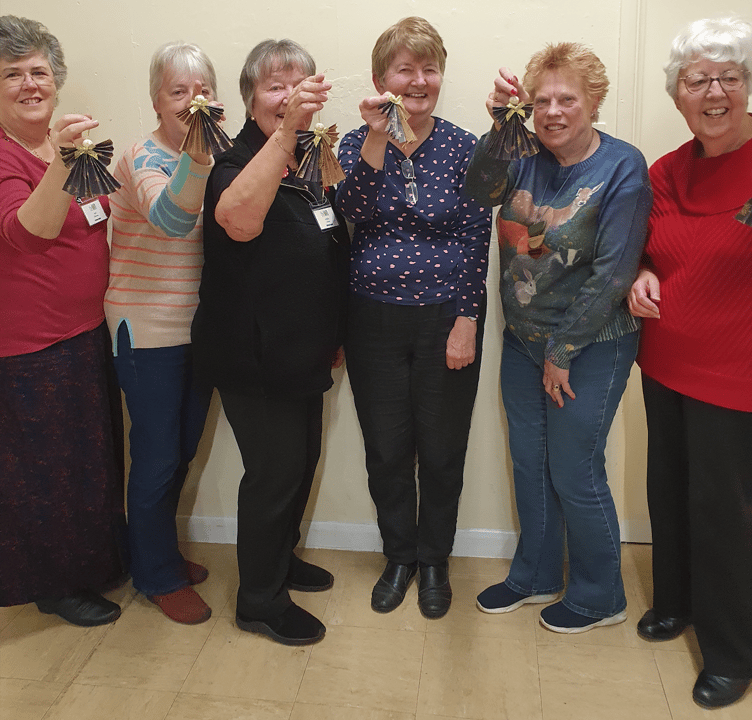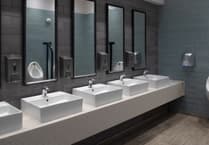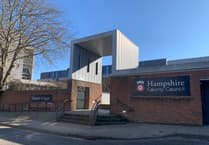Alton WI
Christmas came early for Alton WI members, who crafted Christmas tree angels at their meeting. The beautiful quilt made by the craft group was also on display.
Farnham Book Club
Farnham Book Club met on October 21, when the read was Dead Water by Ann Cleaves, one of the Shetland series.
After a lively discussion, further reads were selected - Enigma by Robert Harris, The Glass Maker by Tracy Chevalier and Table for Two by Amor Towers.
Farnham Book Club is a friendly, welcoming local book club which meets in the Southwest Kiln Room at Farnham Maltings on the third Tuesday of the month at 7.45pm.
Each member has an opportunity to suggest future reads. At the meetings a short presentation is given regarding the current book's author, prior to a discussion about the read.
For more information email Gerald at [email protected], or turn up and join in.
St Peter’s Church Petersfield Bell Ringers
The St Peter’s Church Petersfield Bell Ringers had an autumn outing in West Sussex and attended the Alton and Petersfield district practice in East Meon.
An anti-clockwise ring, old bells dating to 1665, and six, eight and ten bell towers were all part of this year’s autumn outing in West Sussex organised by young ringer Francesco Greenslade - who has rung 361 quarter peals - for the 20 ringers attending.
Pulborough’s 13th-century church was the first tower visited, with the tenor bell dating back to 1665, during the reign of Charles II, and cast by William III and Roger II Purdue.
The walls of the ringing room were festooned with many pictures of old ringers, peal boards and part of an old cracked bell, displayed on a ledge in the tower. With flowered curtained windows, this was a truly delightful ringing room which all the band enjoyed ringing in.
The large St Mary’s Church at Horsham, with a ten-bell tower, was next, with a tenor bell of 22 cwt cast in 1838 by Thomas Mears.
In 1615 the steeple was struck by lightning and a fire started. The large tenor bell was damaged and a girl called Elizabeth Strode, who was standing near the belfry door, was killed.
The oldest bells were the six, three and seven, dating to 1752, the reign of George III. The band rang on the fine set of bells, with methods including plain hunt and bob doubles.
After luncheon in Horsham, the band made a visit to Rudgwick Church of the Holy Trinity, with the unusual eight-bell anti-clockwise ring, which proved something of a challenge.
The last church, set on a hill with stunning views of the valley below Wisborough Green, was the church of St Peter Ad Vincula, parts of which date back to the 11th century, with a wall partly dating to between 1200 and 1250. The ground floor ring of six bells is housed in a tower that might once have acted as a defence tower for the valley. Rounds, call changes, plain hunt and bob doubles were rung at this tower.
Thanks were given to Francesco Greenslade and all the helpers on the day for making such a happy and memorable day of ringing. All are looking forward to the next outing in the spring.
The Alton & Petersfield District practice for October took place at the ten-bell tower at the Norman church of All Saints East Meon.
The tower housing the bells was built in 1150, although the lead-covered broach tower is later, probably 1230, with carvings of scallops and zigzags which are similar to those found at Winchester Cathedral.
In this atmospheric ringing room, the practice was run by the deputy tower captain of St Peter’s Church Petersfield, Rebecca Restall.
The ringing consisted of rounds, call changes, bob doubles, plain hunt and Cambridge doubles. Thanks were given to Rebecca for running an excellent practice.
The next district practice will be at St Peter’s Church Petersfield on November 22 from 7pm to 8.30pm. Anyone interested in learning the art of bell ringing should contact their local church or email bellringing.org and cccbr.org.uk or [email protected]
Petersfield Liberal Democrats
Petersfield Liberal Democrats hosted an open meeting at Winton Houses for a presentation by Kerry Hearsley of The Princess Royal Trust for Carers.
The Princess Royal Trust for Carers, now the Carers Trust, was formed in 1991 by The Princess Royal, Princess Anne, who remains the patron and has been active throughout.
The Hampshire branch was formed 31 years ago by the mayor of Winchester. The impetus for the creation of the charity was the Care in the Community Act, which placed priority of recovering patients being in the community or home, not in hospitals, but the necessary support was lacking.
The number of carers, as recorded in the last census, is largely under-estimated. Many people do not consider themselves as carers, or did not complete the census accurately. It is estimated that one in 15 people - 4.3 million - become carers each year.
Carer has a wide definition - it could be one person giving support to one person for a few hours per week, or someone supporting two people for many hours per week. About 20 per cent of carers support two people, and about five per cent support three people.
There are also perhaps about 130,000 children nationally, some very young, supporting and caring for siblings or parents, sometimes for many hours, including complex medical support. There are about 3,500 children giving this support in Hampshire, and this affects their education and socialising with friends.
The value of the support which carers gives runs into billions, undervalued by many, possibly the same as the total cost of the NHS. Without this input social care, which is already creaking, would collapse.
Carers are usually willing and see it as their role, but they do need support - financial, practical and mental. The problem with the carers’ allowance cliff-edge and clawback, and a limitation for older carers, was highlighted.
Moving on to the current policies affecting carers, the new NHS ten-year strategy has some good elements, but it will be very dependent on there being enough, good and effective support for out-of-hospital care. There is pressure on bed capacity which can lead to the discharge of patients to unprepared carers at home.
There are support hubs provided by the trust in Hampshire, both in-person and virtual, for mutual support and socialising. For individuals there are face-to-face meetings to provide support, and advice of the sources of support.
Covid forced the adoption of online group meetings for some support, which have now continued. These include online baking - ingredients provided - gardening, book groups, exercise, coffee and cake, all helping to reduce isolation.
Baroness Casey is currently inquiring into social care, but change has been postponed many times because of cost and complexity.
Other items raised during discussion included awareness of all disabilities and carers’ needs, the problem of persuading the public that there are real costs which need to be paid for out of taxes, and making sure that the rights given to carers and hospital patients are understood and respected.
In summary, the approach taken by the charity is for carers to ask, and for help to be given how they need it, not to have ideas forced upon them.
Those attending the meeting included some disabled people and carers.
Kerry was thanked for a very informative presentation, for handling questions, and for the work the charity does.
Alton Lions Club
Alton charity Cardiac Health welcomed representatives from Alton Lions Club who presented it with a cheque for £2,500 as the proceeds from its golf day in August.
Sarah Hill from Cardiac Health received the cheque from Lions Dave Crocker, Derek Shaw, Frank Pote and John Smith, watched by Hugh, Siobhan, John and Denise, who formed the winning team Hugh’s Hackers and received commemorative Alton Lions Club polo shirts.
The Alton Lions-Cardiac Health Golf Day is a popular and long-standing fixture on local golfers’ calendars. The four-ball competition, which took place at Test Valley Golf Club on one of the hottest days of the summer, saw 17 teams compete for various prizes for best score, nearest the pin and nearest the line. The round of golf was followed by a two-course meal and a presentation ceremony.
Cardiac Health events manager Denise Ellis said she was “thrilled” with the donation.
She added: “We would like to thank everyone who attended the Lions golf day, and especially the committee who organised such a fabulous fundraising event.
“The money raised from the golf day is going to help Cardiac Health continue improving the health of local people, at a time when fundraising is proving very difficult, so every pound raised has a big impact.”
Cardiac Health - formerly known as Cardiac Rehab, and officially the Basingstoke and Alton Cardiac Rehabilitation Charity - began in 1976 at the old Alton Sports Centre before making a short move to a purpose-built facility in Chawton Park Road in 1997.



.jpeg?width=209&height=140&crop=209:145,smart&quality=75)


Comments
This article has no comments yet. Be the first to leave a comment.